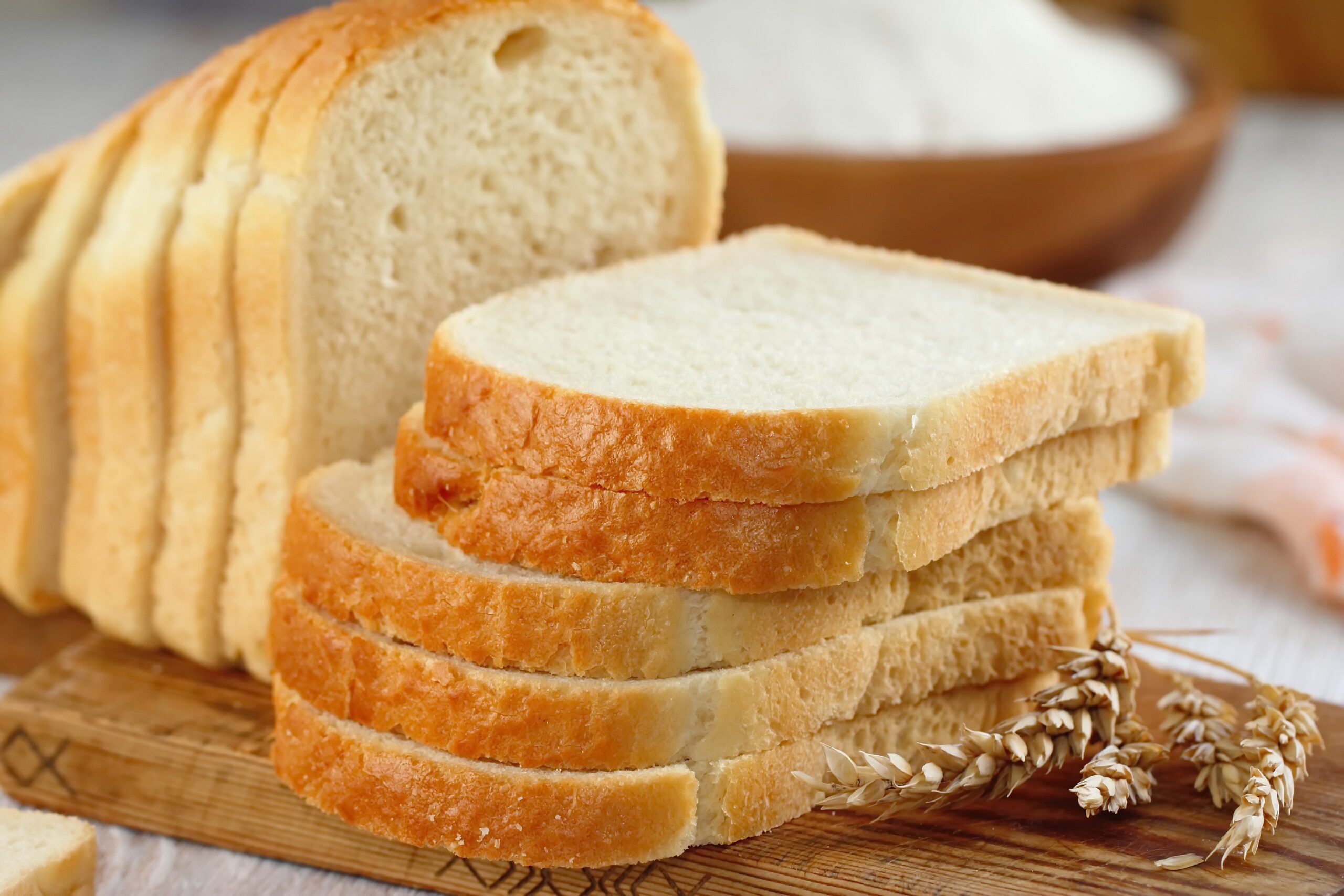Additives in White Bread Linked to Cancer, Respiratory Problems, and Other Toxic Effects
June 14, 2024
 766
766 
Traditionally, white bread in the USA is made through a process that includes mixing, fermentation, proofing, baking, cooling, slicing, and packaging. This process uses basic ingredients like wheat flour enriched with vitamins and minerals (such as niacin, iron, thiamine mononitrate, riboflavin, and folic acid), water, yeast, salt, sugar, and fat (such as butter, vegetable oil, or lard).
Unfortunately, they do not tell us about all the other additives used in this process that help cut baking costs, extend the bread’s shelf life, and ensure a consistent supply.
Many of these additives are banned in other countries and have shown evidence that they may be detrimental to your health, affecting your diet and fitness goals. Today, we are revealing the full list with the hope that you can make better decisions for you and your family’s health:
The key difference between European regulations and American regulations lies in that Europe takes a precautionary approach. They ban many additives that may be linked to potential health risks. On the other hand, the FDA still permits their use based on the “generally recognized as safe” designation until proven.
Some experts argue this results in greater exposure to potentially harmful substances for Americans compared to European. However, the FDA maintains its evaluation process ensures safety before approval.
You be the judge!
Keep these facts in mind…
RE: Lobbying and Business Interests- Experts have pointed out that lobbying and business interests have influenced the U.S. Dietary Guidelines for Americans. The guidelines have been criticized for being unduly influenced by food manufacturers and special interest groups. This influence leads to the perpetuation of outdated research and recommendations that do not align with the latest scientific evidence.
We recommend avoiding ultra-processed breads with lengthy ingredient lists and supporting local bakeries who use simpler methods and ingredients, or try baking at home to limit exposure to controversial additives.
Ezekiel bread is made from a mix of sprouted whole grains and legumes, including wheat, barley, spelt, millet, soybeans, and lentils. The sprouting process increases nutrient availability and makes the bread more easily digestible. It is also free from added sugars.
Sourdough bread is made from fermented grains, which reduces antinutrients and increases nutrient availability. It has a lower glycemic index compared to regular white bread, making it a better option for blood sugar control. However, it still contains gluten
Whole grain rye, is rich in fiber, B vitamins, and plant compounds called lignans. It supports gut health and has a lower glycemic index, which helps ito maintain stable blood sugar levels.
Sprouted grain bread is made from grains that have been allowed to sprout before being processed. This process reduces enzyme inhibitors and increases nutrient absorption. It is a good source of fiber, protein, and various vitamins and minerals.
Almond bread is a grain-free and gluten-free alternative made with almond flour, eggs, and spices. It is high in protein and fiber, making it suitable for those following a Paleo diet or those with gluten sensitivities. These alternatives offer various health benefits, including improved nutrient absorption, better blood sugar control, and enhanced digestive health.
While people have long made commercially produced white bread a staple in their diets, growing worries now focus on the potential health risks of some chemicals and the lack of emphasis on whole grains. This has prompted many people to seek alternative healthy diet foods that better match their dietary goals.
Choosing whole grain alternatives, which retain their natural nutrients and fiber, can provide a healthier option for maintaining a balanced diet.
https://www.prevention.com/food-nutrition/g20473340/healthiest-sandwich-bread/
https://www.bbcgoodfood.com/howto/guide/what-is-the-healthiest-bread
https://foodbabe.com/healthiest-bread-on-the-market/
https://www.world-grain.com/articles/18253-does-gm-wheat-have-future-in-us
https://www.farmprogress.com/farm-operations/fda-proposes-voluntary-healthy-food-label-claim
https://time.com/4130043/lobbying-politics-dietary-guidelines/
https://www.ncbi.nlm.nih.gov/pmc/articles/PMC8834264/
https://www.eurofinsus.com/food-testing/resources/usda-vs-fda-food-labeling/
https://www.fda.gov/inspections-compliance-enforcement-and-criminal-investigations/inspection-guides/guide-inspections-grain-product-manufacturers
https://www.ers.usda.gov/topics/food-markets-prices/processing-marketing/food-and-beverage-manufacturing/
https://www.bakeryandsnacks.com/Article/2013/08/20/When-will-FDA-finalize-guidance-on-whole-grain-labeling-statements
https://www.theguardian.com/us-news/2019/may/28/bread-additives-chemicals-us-toxic-america
https://www.knowyourrightscamp.org/post/experts-say-u-s-food-additives-banned-in-europe-are-almost-certainly-making-americans-sick
https://www.knowyourrightscamp.org/post/experts-say-u-s-food-additives-banned-in-europe-are-almost-certainly-making-americans-sick
https://nypost.com/2023/02/21/food-additives-banned-in-europe-are-certainly-making-americans-sick-experts/
https://www.greenlifephilosophy.com/what-is-wrong-with-bread-in-america/
https://www.livestrong.com/slideshow/1011109-10-ingredients-always-avoid-bread-plus-7-bread-brands-bets/
https://thebrotbox.com/blogs/news/difference-between-american-vs-european-wheat
https://bulknaturalfoods.com/articles/which-wheat-for-what/
https://www.thefreshloaf.com/node/71763/us-flour-vs-nonus-flour
https://www.delaheart.com/blogs/food/the-differences-between-american-european-wheat-gluten
https://www.ncbi.nlm.nih.gov/pmc/articles/PMC7497585/
https://pubmed.ncbi.nlm.nih.gov/3812500/
https://explore.globalhealing.com/what-is-azodicarbonamide/
https://www.fda.gov/about-fda/histories-product-regulation/food-standards-under-1938-food-drug-and-cosmetic-act-bread-and-jam
https://www.ncbi.nlm.nih.gov/pmc/articles/PMC8834264/
https://www.fda.gov/food/food-additives-petitions/azodicarbonamide-ada-frequently-asked-questions

A new study suggests that a widely used sugar substitute found in diet sodas, chewing gum, and low-sugar yogurt may elevate insulin levels. This could increase the long-term risk of heart disease. “Artificial sweeteners have infiltrated nearly all types of food, making it crucial to understand their long-term health effects,” said Yihai Cao, senior author […]

Diet Coke has long been a fan-favorite among soda lovers who want a fizzy, guilt-free alternative to traditional soft drinks. While its zero-calorie, zero-sugar label makes it seem like a healthier option, the reality is far more concerning. Despite its undeniable popularity, Diet Coke’s nutritional profile has raised red flags among health experts for years. […]

New study shows that embracing an anti-inflammatory, plant-forward diet can support cognitive function and help reduce the risk of dementia. What You Eat Shapes Your Brain The food you eat doesn’t just impact your body—it also affects your brain. Research suggests that eating an anti-inflammatory, plant-based diet can help improve memory, focus, and overall brain […]